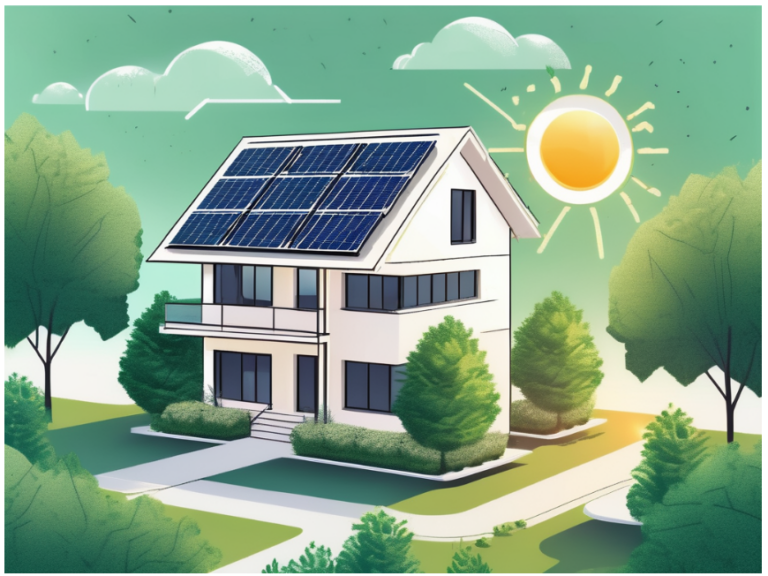Green Hearts: Spreading Love with Home Eco Grants this February
February is a month of love and a time to show kindness to both our loved ones and the environment. It is the perfect opportunity to embrace eco-friendly practices and make a positive impact on our homes and communities. At Green Hearts, we believe in spreading love not just through our actions but also through our Home Eco Grants. These grants provide homeowners with the financial support they need to make sustainable improvements to their homes, promoting a greener and more environmentally friendly way of living.
Understanding the concept of home eco grants
Home eco grants are financial incentives provided to homeowners to encourage them to adopt eco-friendly practices and make sustainable improvements to their properties. These grants are often funded by government or private organisations, to reduce carbon footprints and promote greener living.
The importance of eco-friendly living
Living in an eco-friendly manner is not only beneficial for the environment but also for our well-being. Adopting sustainable practices reduces energy consumption, minimises waste, and helps preserve natural resources. By making small changes to our lifestyles, we can significantly contribute to a healthier and greener planet.
For instance, one of the most effective ways to reduce energy consumption is by using energy-efficient appliances and lighting. By replacing traditional incandescent light bulbs with LED bulbs, homeowners can save a significant amount of energy and reduce their carbon footprint. Additionally, installing insulation in walls and roofs can help retain heat during the colder months, reducing the need for excessive heating and saving energy.
Another important aspect of eco-friendly living is water conservation. By implementing measures such as installing low-flow showerheads and faucets, homeowners can reduce water wastage and contribute to the preservation of this precious resource. Rainwater harvesting systems can also be installed to collect rainwater for various uses, such as watering plants and flushing toilets.
How home eco grants support sustainable practices
Home eco grants play a vital role in supporting sustainable practices by providing homeowners with the financial means to implement eco-friendly improvements. These grants can be used for various purposes such as energy-efficient upgrades, water conservation measures, and renewable energy installations. By offering financial incentives, home eco grants make it easier for homeowners to make these important changes.
For example, homeowners can use eco grants to install solar panels on their roofs, which generate clean and renewable energy. This not only reduces reliance on fossil fuels but also helps homeowners save on their electricity bills in the long run. Similarly, grants can be used to upgrade old and inefficient heating systems with more energy-efficient alternatives, such as heat pumps or biomass boilers.
Furthermore, home eco grants can support the installation of smart home technologies that promote energy efficiency. These technologies, such as smart thermostats and energy monitoring systems, allow homeowners to have better control over their energy usage and make informed decisions to reduce wastage. By utilising these grants, homeowners can embrace a more sustainable and energy-conscious lifestyle.
In conclusion, home eco grants are an essential tool in encouraging homeowners to adopt eco-friendly practices and make sustainable improvements to their properties. By providing financial support, these grants enable homeowners to invest in energy-efficient upgrades, water conservation measures, and renewable energy installations. Ultimately, the widespread adoption of eco-friendly practices supported by home eco grants can contribute to a greener and more sustainable future for all.
The role of Green Hearts in promoting eco grants
Green Hearts is a pioneering organisation dedicated to promoting sustainable living and environmental conservation. Our mission is to empower individuals and communities to make eco-friendly choices and create a greener future for all.
But what exactly does sustainable living entail? Sustainable living is a lifestyle that aims to reduce an individual’s or community’s use of Earth’s natural resources. It involves making conscious choices that minimise waste, conserve energy, and protect the environment. By adopting sustainable practices, we can ensure that future generations have access to clean air, water, and a healthy planet.
The mission and vision of Green Hearts
At Green Hearts, we believe that every small step towards sustainability counts. Our mission is to inspire and assist individuals in adopting greener practices and making eco-conscious decisions. We envision a world where eco-friendly living is the norm, and every homeowner has access to the resources needed to create a sustainable home.
Imagine waking up in a house that not only provides shelter but also generates its own clean energy, collects rainwater for reuse, and incorporates natural materials that are kind to the environment. This is the vision we have for every homeowner – a sustainable home that not only benefits the planet but also enhances the quality of life for its occupants.
The impact of Green Hearts’ initiatives
Since its inception, Green Hearts has made a significant impact on promoting eco grants and sustainable living. Through awareness campaigns, community outreach programs, and partnerships with government bodies, we have successfully encouraged homeowners to embrace eco-friendly practices.
One of our most successful initiatives is the Eco Grants program. This program provides financial support to homeowners who want to make sustainable upgrades to their homes. By offering grants for solar panel installations, energy-efficient appliances, and water-saving systems, we have incentivised homeowners to take action and reduce their carbon footprint.
But our impact goes beyond just the numbers. We have witnessed firsthand the transformation of countless homes into eco-friendly havens. From simple changes like switching to LED light bulbs to more significant investments like installing green roofs, these homeowners have not only reduced their environmental impact but also created healthier living spaces for themselves and their families.
Moreover, our initiatives have had a ripple effect on communities. By inspiring one homeowner to make sustainable changes, we have sparked conversations and motivated others to follow suit. This domino effect has resulted in a collective effort towards a greener future, with neighbourhoods coming together to implement community gardens, recycling programs, and renewable energy projects.
As we continue our journey towards a sustainable future, Green Hearts remains committed to expanding our reach and impact. Through ongoing research, innovation, and collaboration, we strive to develop new initiatives that empower individuals and communities to embrace eco-friendly practices.
Applying for a home eco grant this February
Securing a home eco grant can be a straightforward process if you meet the eligibility criteria and understand the application process. Here is what you need to know:
Eligibility criteria for the grant
To be eligible for a home eco grant, you need to meet certain criteria, which may vary depending on the organisation providing the grant. Typically, homeowners need to demonstrate their commitment to making sustainable improvements and show how these changes will benefit the environment and their community.
One important criterion is the homeowner’s dedication to sustainable living. This can be demonstrated through previous eco-friendly initiatives undertaken by the homeowner, such as installing energy-efficient appliances or implementing recycling programs. Additionally, homeowners may need to provide evidence of their involvement in community projects that promote environmental sustainability.
Furthermore, organisations offering home eco grants often prioritise applicants who have a clear plan for how they will utilise the grant funds. This plan should outline the specific eco-friendly improvements the homeowner intends to make, such as installing solar panels, improving insulation, or upgrading to energy-efficient heating systems. The more detailed and comprehensive the plan, the higher the chances of securing the grant.
The application process explained
The application process for a home eco grant typically involves submitting an application form along with supporting documents that outline the proposed sustainable improvements. It is crucial to provide comprehensive details and evidence to strengthen your case.
When filling out the application form, it is essential to be clear and concise in explaining your intentions and how the grant will contribute to your eco-friendly goals. This includes detailing the specific improvements you plan to make, the expected environmental impact, and any anticipated cost savings resulting from these changes. Providing accurate and well-researched information will demonstrate your commitment and increase your chances of success.
Supporting documents play a crucial role in the application process. These documents may include quotes from contractors or suppliers, architectural plans, and energy efficiency assessments. Including these supporting documents will provide the grant provider with a comprehensive understanding of your proposed improvements and their potential impact.
Once submitted, the application will be assessed by a panel of experts who specialise in sustainable living and environmental conservation. They will carefully review each application, taking into consideration the eligibility criteria and the potential impact of the proposed improvements. This thorough evaluation process ensures that the grants are awarded to those who are genuinely committed to making a positive change.
If your application is successful, you will be awarded the grant to proceed with the eco-friendly improvements outlined in your application. The grant funds can be used to cover the cost of materials, labour, and any other expenses directly related to the approved improvements.
It is important to note that the application process may vary slightly depending on the organisation providing the grant. Therefore, it is advisable to thoroughly research the specific requirements and guidelines of the grant you are applying for to ensure a successful application.
Maximising the benefits of your Home Eco grant
Receiving a home eco grant is just the first step towards a greener home. To make the most of your grant and maximise its benefits, consider the following tips:
Tips for using your grant effectively
1. Plan strategically: Take the time to plan your eco-friendly improvements before diving in. Consider the areas of your home that require the most attention and prioritise accordingly.
Planning is a crucial step in ensuring that your eco-friendly improvements are successful. By carefully assessing the needs of your home, you can identify the areas that will benefit the most from your grant. For example, if you live in a region with cold winters, prioritising insulation upgrades can significantly reduce your energy consumption and heating costs.
2. Seek professional advice: Consult experts in sustainable construction or energy efficiency to ensure that your improvements are well-planned and effective.
Professional advice can provide valuable insights and recommendations for your eco-friendly home improvements. Architects, contractors, and energy consultants can assess your home’s specific needs and suggest the most suitable upgrades. They can also help you navigate any building regulations or permits that may be required for certain projects.
3. Research eco-friendly options: Look for sustainable materials and appliances that will not only reduce your environmental impact but also save you money in the long run.
When selecting materials and appliances for your eco-friendly upgrades, it’s important to consider their long-term benefits. For example, investing in energy-efficient windows may have a higher upfront cost, but they can significantly reduce your heating and cooling expenses over time. Similarly, choosing sustainable materials like bamboo flooring or recycled glass countertops can enhance the eco-friendliness of your home while adding a unique touch to your decor.
4. Monitor your progress: Keep track of the energy and water savings resulting from your eco-friendly improvements. This will not only help you see the positive impact you’re making but also assist in future sustainability efforts.
Tracking your progress is essential to understand the effectiveness of your eco-friendly upgrades. By monitoring your energy and water usage before and after the improvements, you can quantify the savings and environmental benefits. This data can also guide you in making further sustainable choices for your home, such as adjusting your energy consumption habits or exploring additional eco-friendly technologies.
Sustainable home improvements to consider
1. Energy-efficient upgrades: Insulate your home, install energy-efficient windows and appliances, and consider renewable energy sources such as solar panels.
Energy-efficient upgrades are key to reducing your carbon footprint and saving on utility bills. Proper insulation can prevent heat loss during winter and keep your home cool in summer, reducing the need for excessive heating or air conditioning. Energy-efficient windows can minimise heat transfer and improve insulation while energy-saving appliances consume less electricity. Additionally, installing solar panels can generate clean and renewable energy, further reducing your reliance on fossil fuels.
2. Water conservation measures: Install low-flow faucets and toilets, collect rainwater for gardening, and invest in efficient irrigation systems.
Conserving water is crucial for sustainable living, especially in regions prone to drought or water scarcity. Low-flow faucets and toilets can significantly reduce water usage without compromising functionality. Collecting rainwater for gardening purposes can help reduce reliance on municipal water supplies, while efficient irrigation systems can ensure that your plants receive just the right amount of water, minimising waste.
3. Waste reduction strategies: Recycle and compost, minimise single-use plastics, and choose sustainable materials for home furnishings and decor.
Reducing waste is an essential aspect of sustainable living. Implementing recycling and composting practices can divert a significant amount of waste from landfills, reducing environmental pollution. Minimising the use of single-use plastics, such as opting for reusable shopping bags and water bottles, can help combat plastic pollution. Additionally, choosing sustainable materials for home furnishings and decor, such as reclaimed wood or upcycled furniture, can add a unique touch to your home while promoting a circular economy.
The future of home eco grants and Green Hearts
As we look ahead, both home eco grants and Green Hearts have exciting plans to further promote sustainable living and create a greener future:
Upcoming initiatives from Green Hearts
Green Hearts is committed to expanding its reach and impact by launching new programs and initiatives aimed at empowering homeowners and entire communities to embrace eco-friendly practices. Keep an eye out for our upcoming projects, partnerships, and events.
The long-term impact of home eco grants
Home eco grants are an essential tool in creating a sustainable future. As more homeowners adopt eco-friendly practices with the help of these grants, we can expect a significant reduction in carbon footprints, increased energy efficiency, and a greater awareness of environmental conservation. Green Hearts will continue to advocate for home eco grants to ensure a long-term, positive impact on the environment.
This February, let’s spread love not only to our loved ones but also to the environment. Apply for a home eco grant, make sustainable improvements to your home, and join us in creating a greener future for all. Together, we can make a difference.



